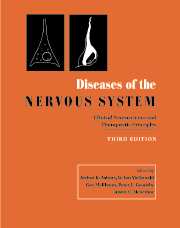Book contents
- Frontmatter
- Dedication
- Contents
- List of contributors
- Editor's preface
- PART I INTRODUCTION AND GENERAL PRINCIPLES
- PART II DISORDERS OF HIGHER FUNCTION
- PART III DISORDERS OF MOTOR CONTROL
- 31 Mechanisms of motor control
- 32 The apraxias
- 33 Parkinson's disease
- 34 Other extrapyramidal syndromes: parkinsonism-plus and other forms of secondary parkinsonism
- 35 Tremors
- 36 Myoclonus
- 37 Dystonia
- 38 Tourette syndrome
- 39 Cerebral palsy
- 40 Gait and balance disorders
- PART IV DISORDERS OF THE SPECIAL SENSES
- PART V DISORDERS OF SPINE AND SPINAL CORD
- PART VI DISORDERS OF BODY FUNCTION
- PART VII HEADACHE AND PAIN
- PART VIII NEUROMUSCULAR DISORDERS
- PART IX EPILEPSY
- PART X CEREBROVASCULAR DISORDERS
- PART XI NEOPLASTIC DISORDERS
- PART XII AUTOIMMUNE DISORDERS
- PART XIII DISORDERS OF MYELIN
- PART XIV INFECTIONS
- PART XV TRAUMA AND TOXIC DISORDERS
- PART XVI DEGENERATIVE DISORDERS
- PART XVII NEUROLOGICAL MANIFESTATIONS OF SYSTEMIC CONDITIONS
- Complete two-volume index
- Plate Section
36 - Myoclonus
from PART III - DISORDERS OF MOTOR CONTROL
Published online by Cambridge University Press: 05 August 2016
- Frontmatter
- Dedication
- Contents
- List of contributors
- Editor's preface
- PART I INTRODUCTION AND GENERAL PRINCIPLES
- PART II DISORDERS OF HIGHER FUNCTION
- PART III DISORDERS OF MOTOR CONTROL
- 31 Mechanisms of motor control
- 32 The apraxias
- 33 Parkinson's disease
- 34 Other extrapyramidal syndromes: parkinsonism-plus and other forms of secondary parkinsonism
- 35 Tremors
- 36 Myoclonus
- 37 Dystonia
- 38 Tourette syndrome
- 39 Cerebral palsy
- 40 Gait and balance disorders
- PART IV DISORDERS OF THE SPECIAL SENSES
- PART V DISORDERS OF SPINE AND SPINAL CORD
- PART VI DISORDERS OF BODY FUNCTION
- PART VII HEADACHE AND PAIN
- PART VIII NEUROMUSCULAR DISORDERS
- PART IX EPILEPSY
- PART X CEREBROVASCULAR DISORDERS
- PART XI NEOPLASTIC DISORDERS
- PART XII AUTOIMMUNE DISORDERS
- PART XIII DISORDERS OF MYELIN
- PART XIV INFECTIONS
- PART XV TRAUMA AND TOXIC DISORDERS
- PART XVI DEGENERATIVE DISORDERS
- PART XVII NEUROLOGICAL MANIFESTATIONS OF SYSTEMIC CONDITIONS
- Complete two-volume index
- Plate Section
Summary
Myoclonus is defined as shock-like involuntary movements. Most often these are due to brief bursts of muscle activity, resulting in positive myoclonus. Jerks, however, may also result from sudden short inhibitions of ongoing tonic muscle activity, termed negative myoclonus or asterixis. Myoclonus may be physiological, such as hiccups, or due to a variety of hereditary or acquired conditions. In particular, it may be seen in primary generalized epilepsy, but as this syndrome is dominated by epilepsy rather than myoclonus, it will not be considered further here.
Clinical overview of physiologically based classification
Although etiological classifications have not proven very useful in predicting the response to drugs, electrophysiological investigations have been able to distinguish several different pathophysiological mechanisms with therapeutic implications. To a large degree, the pathophysiological type of myoclonus can be suspected on clinical grounds. The most useful clinical distinction is between generalized, multifocal and focal/segmental jerks. Generalized myoclonus involves the majority of the body in a synchronous jerk. It may spare the face and be predominantly axial, as in propriospinal myoclonus, or include the face, as in brainstem myoclonus. The latter may only consist of reflex jerks, as in exaggerated startle/hyperekplexia, or may also involve prominent spontaneous jerks as in brainstem reticular reflex myoclonus. A useful confirmatory sign of a brainstem origin is the presence of jerks in response to auditory stimulation, particularly unexpected sounds. Multifocal myoclonus involves different parts of the body at different times. There may also be the occasional generalized jerk, but the clinical picture is dominated by multifocal jerks. Such patients may be divided into those in whom the distal limbs are especially involved, and are likely to have cortical myoclonus, and those in whom the jerks are most noticeable proximally, particularly round the shoulders. These are likely to have essential myoclonus. Helpful confirmatory signs of cortical and essential myoclonus are an exacerbation of jerking upon voluntary action and the presence of dystonic posturing, respectively. Focal/segmental jerks are the most obscure as they may arise at virtually any level of the nervous system, including the spinal cord.
Clinical suspicion of particular pathophysiological types of myoclonus can be supported by simple investigation.
- Type
- Chapter
- Information
- Diseases of the Nervous SystemClinical Neuroscience and Therapeutic Principles, pp. 523 - 531Publisher: Cambridge University PressPrint publication year: 2002

